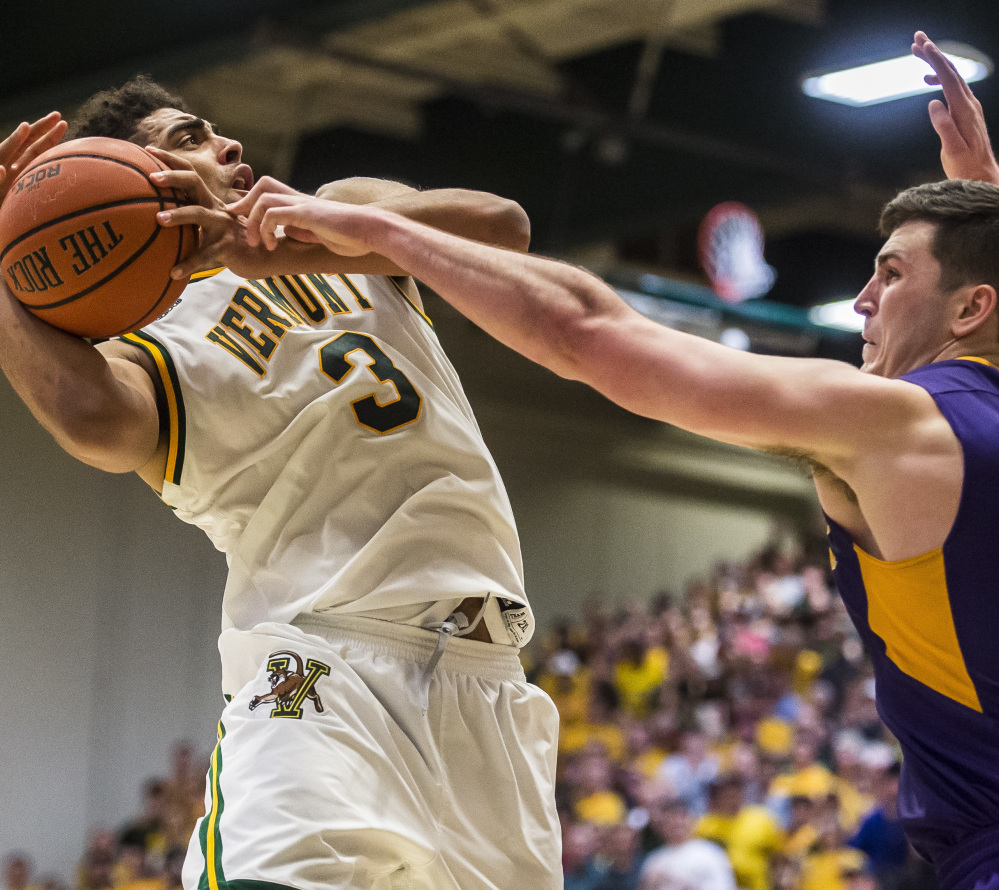The blank bracket represents 63 predictions waiting to be made, with upsets and surprises lurking throughout. If you’re looking for an under-the-radar pick, recent history might help with useful prototypes for what a surprise team looks like. Using last year’s bracket as a guide, here are some teams that fit the mold of surprise successes.
• If you liked Stephen F. Austin last year, you’ll like Vermont this year.
The Lumberjacks dominated a weak conference – the Southland – and emerged as a tournament threat that had not lost in league play. Vermont followed the same path, winning all 19 of its America East games, including three in the conference tournament by an average of 27 points. Like Stephen F. Austin before it, Vermont was simply too good for its league. For the Lumberjacks, it was good enough to topple West Virginia handily and push Notre Dame to the limit as a 14 seed.
One major difference between SFA and 13th-seeded Vermont is how each was constructed. The Lumberjacks were built around senior Thomas Walkup, a one-man wrecking crew who led them in just about every statistical category. No Catamounts have scored more than 12.6 points per game, the average of Anthony Lamb, a freshman forward.
The Catamounts will provide a tricky matchup for other reasons. They played at the 326th slowest pace of 351 Division I teams, but made 50 percent of their field-goal attempts, which ranked seventh in the country. They have no player taller than 6-foot-8 and did not rebound especially well, even in the America East, and so they could struggle with Purdue’s size, especially player of the year candidate Caleb Swanigan.
• If you liked Villanova last year, you’ll like SMU this year.
Villanova hid in plain sight last year, a No. 2 seed that received scant attention as a national title contender until it cleaved through the bracket and won the national title. The Wildcats were overlooked despite a red-hot finish, probably because they played in the Big East, a power conference widely considered to be a tick below the Big Ten, ACC, Big 12 and Pac-12.
Who might be an accomplished-yet-stealth national title threat this year? Out of the American Athletic Conference comes SMU (30-4), a team that enters the tournament having won 26 of 27, its only loss since December coming in a 66-64 squeaker at Cincinnati on Jan. 12. Coach Tim Jankovich, who replaced Larry Brown midway through last season, is a national coach of the year candidate. And yet, the position-free Ponies received only a 6 seed.
Besides star Semi Ojeleye, a 6-8 junior who averages 18.5 points and 6.5 rebounds, there’s plenty to like about SMU. It does a couple things at an elite level. The Mustangs have grabbed 57.2 percent of available rebounds, which ranks third in the country behind North Carolina and St. Mary’s. And they share the ball – only nine teams assisted on a higher percentage of their baskets. They’re headed for a possible second-round matchup with Baylor, which under Scott Drew has been a near-annual tournament flop.
• If you liked Yale last year, you’ll like South Dakota State this year.
Every March thrusts forward an off-the-grid player who dazzles the country on Thursday or Friday. Last year, Yale guard Makai Mason dropped 31 points in an upset over Baylor. South Dakota State has a player capable of a similar star turn in Mike Daum, a sophomore from tiny Kimball, Nebraska, who rates among the most efficient players in the country.
At 6-9, Daum averaged 25.3 points on 15.2 shots per game, converting better than 50 percent of his shots from inside the arc, better than 40 percent from 3-point range and nearly 90 percent from the foul line. Daum shoots more than five 3s per game, but he has enough of an inside game to lead the country in free-throw attempts.
He pairs his efficiency with high volume – Daum scored 37 points in SDSU’s 79-77 victory over Nebraska-Omaha in the Summit League title game, and in mid-February he scored 51 in a game on 29 shots. He hasn’t proven it against tournament-caliber competition, but he knows how to take over.
The last unreached frontier in NCAA tournament chaos remains a 16 seed toppling a 1. The Jackrabbits fit the theoretical profile of a team that could pull it off. They have experience, having advanced to four tournaments in six seasons, including last year, when they gave Maryland a brief scare as a 12 seed. They stumbled to a 12-16 record under first-year coach T.J. Otzelberger before winning their final six games, a run that suggests they’re more talented than their seed. Daum gives the Jackrabbits the rare chance for a 16 seed to send out one of the best players on the floor.
If SDSU can actually topple Gonzaga, file away some requisite biographical data: Daum’s mother, Michele, retired as the career leading scorer at Wyoming, and his father, Mitch, played tight end at Wyoming and then briefly in the NFL.
• If you liked Notre Dame last year, you’ll like Oklahoma State this year.
The Fighting Irish, after a regular season spent as a middle-of-the-pack power conference team, advanced to the Elite Eight last March despite a well-earned reputation for not playing much defense, reliant instead on one of the best offenses in the country. This year’s under-the-radar team with a lethal offense capable of carrying a sagging defense could be 10 seed Oklahoma State.
The Cowboys, who finished fifth in the Big 12, allowed 78 points per game, which ranked 303rd in Division 1. But they’ve also scored 85.5 points per game and own the highest rated offense in the country per statistician Ken Pomeroy’s rankings. Their offense is built on a combination of muscle and long-range shooting – they rebounded 37.8 percent of their own misses, the fifth-best rate in the country, and made 40.1 percent of 3-point attempts, good for 16th in the nation.
Oklahoma State hasn’t won a tournament game since 2009, but it boasts a few factors to counteract recent history. Coach Brad Underwood took over this season after leading Stephen F. Austin to three consecutive NCAA tournaments, which included two victories. Guards tend to dominate in March, and the Cowboys have one of the most explosive backcourts in the country in sophomore Jawun Evans and Jeffery Carroll.
They’ll face a difficult task against Michigan.
• If you liked Syracuse last year, you’ll like Michigan State this year.
The Orange squeaked into the field last year despite a rocky season, and all of a sudden their seasoned coach led a talented team all the way to the Final Four. Coming off last year’s shocking first-round upset to 15th-seeded Middle Tennessee State, the Spartans, perennially dangerous under Tom Izzo, enter as a 9 seed, in the uncommon position of being overlooked.
A freshman, Malachi Richardson, helped key the Orange’s surprise run to the Final Four. If the Spartans follow suit, they’ll need to rely on 6-7 forward Miles Bridges, the unanimous Big Ten freshman of the year. Bridges averaged 16.6 points and 8.3 rebounds.
Michigan State doesn’t have much to boast beyond Bridges, but Syracuse seemed to be sitting on the wrong side of the bubble before it reeled off four wins in two weeks. It’s hard to knock out a program with pedigree and a coach with a national title on his record.
Copy the Story LinkSend questions/comments to the editors.




Success. Please wait for the page to reload. If the page does not reload within 5 seconds, please refresh the page.
Enter your email and password to access comments.
Hi, to comment on stories you must . This profile is in addition to your subscription and website login.
Already have a commenting profile? .
Invalid username/password.
Please check your email to confirm and complete your registration.
Only subscribers are eligible to post comments. Please subscribe or login first for digital access. Here’s why.
Use the form below to reset your password. When you've submitted your account email, we will send an email with a reset code.